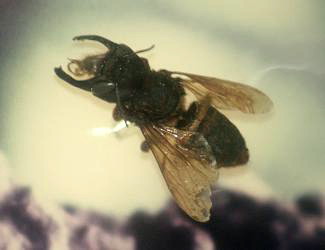- Series:Animals, Transcript English
Romans 1:20
“For the invisible things of him from the creation of the world are clearly seen, being understood by the things that are made, [even] his eternal power and Godhead; so that they are without excuse…”
For over a century it was a bee of legend. The native people on the Indonesian island where it lives call it the “king bee.” The king bee was first described by a scientist in the 1800s. Then, despite a century of looking, the largest bee in the world was not seen again until the 1980s.
 The king bee is about the size of a hummingbird. Scientists say that it sounds much like a hummingbird as it flies. Besides its size, the female king bee can be easily identified by its huge mandibles or jaws. It uses the mandibles to collect resin that oozes from trees in its jungle home. The resin is collected, formed into a ball by the mandibles, and then held in them while being returned to the nest. Male king bees are smaller and have more proportional mandibles.
The king bee is about the size of a hummingbird. Scientists say that it sounds much like a hummingbird as it flies. Besides its size, the female king bee can be easily identified by its huge mandibles or jaws. It uses the mandibles to collect resin that oozes from trees in its jungle home. The resin is collected, formed into a ball by the mandibles, and then held in them while being returned to the nest. Male king bees are smaller and have more proportional mandibles.
King bee nests are about the size of basketballs. They are built inside tree-dwelling termite nests. The bee uses tree resin to build its nest because the resin offers nothing of nutritional interest to the termites. The plastic-like tubes of tree resin within the bee nest cannot be destroyed by the termites. One of the scientists studying the bees reports that their sting is not as painful as a honeybee’s and that, in general, king bees are not aggressive.
The huge king bee has been carefully designed to make its home safe, even among termites. The size and intelligence of this wonderful creature witness to the Godhead of our Creator.
Prayer:
Lord, I thank You that I am filled with wonder as I see yet another example of the truth that there is no end to Your creativity and wisdom! Let me glorify You in my life by witnessing to Your saving truth in the forgiveness of sins. Amen.
Notes:
J. A. Miller. 1984. “Jungle Jaws: Giant Bee Rediscovered on Indonesian Islands.” Science News, May 12, p. 293. Photo: Indonesian Megachile pluto. Courtesy of Stavenn. Licensed under the Creative Commons Attribution-Share Alike 3.0 Unported license.
